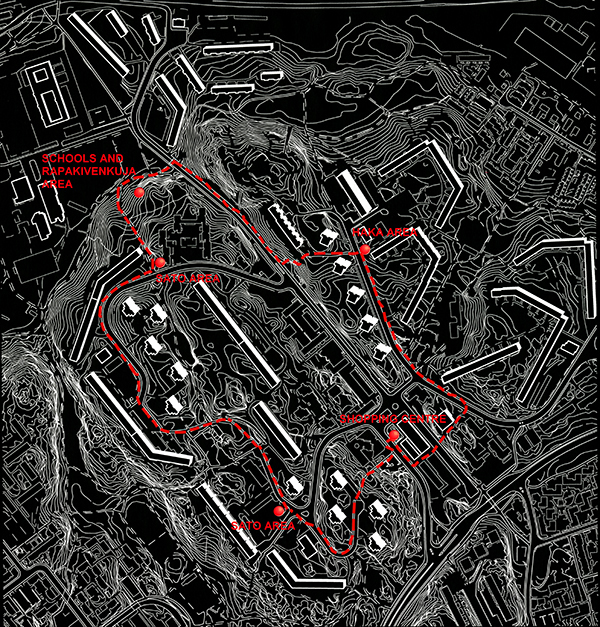PIHLAJAMÄKI |
|||||||
|
“We anchor the buildings to rocky slopes and let the crane tracks crawl along the structure’s concrete slabs without disturbing nature.”- Architect Lauri Silvennoinen, 1964
The suburb of Pihlajamäki was for the most part designed and built during the years 1959 – 1965. The area is an impressive demonstration of the enthusiasm and effort exhibited by the architects of that time as they participated in the building of Finland’s welfare society. Pihlajamäki was one of the first mass production housing areas in Finland. The design work began in 1959 when the Helsinki City Council decided to hand over the Aarnikanmäki area, approximately 65 hectares, for construction. The task of drawing up the town plan was assigned to architect Olli Kivinen, one of that period’s leading town planners. Haka and Sato, Pihlajamäki’s buildersTo ensure political fairness, the construction of Pihlajamäki was divided between two developer organisations. The Helsinki Housing Co-operative (Helsingin Asuntokeskuskunta Haka) was assigned the construction of the area’s northeastern section and Social Housing Production (Sosiaalinen asuntotuotanto Oy Sato) the area’s southwestern part. The town planning of the Haka area continued in co-operation with the architects Esko Korhonen and Sulo Savolainen from the housing department of the Central Union of Consumer Co-operatives. On the Haka side the starting points for the design included the skilful use of the existing terrain forms and the preservation of the natural surroundings. Architect Lauri Silvennoinen, who in his proposal further developed Olli Kivinen’s town planning concepts, won an architectural design competition organised in 1960 for the design of the Sato area. In terms of the design approaches, the Sato side was more monumental and treated the surroundings more broad-mindedly. The town plan for the northern section of Pihlajamäki was drawn up in 1962 according to Olli Kivinen’s design. At Pihlajamäki, prefabrication was applied for the first time on a large scale in Finland. Large shuttering moulds and half element technology were utilised on both the Haka and Sato sides; the Sato area at Vuolukiventie was the first site where a completely prefabricated system was implemented. Prefabrication was seen as an economical way to produce modern apartments for a country experiencing a period of rapid urbanisation. Pihlajamäki’s cellular town planPihlajamäki’s town plan is based on five cells that were designed as separate entities with local shops. The cells were located along cul-de-sacs, two at the southwestern section’s rocky uplands, two at the area’s northeastern part, and the fifth residential cell at the northern area’s low-lying terrain. Besides safeguarding the natural surroundings, a striving for architectonic impressiveness also guided the siting of the buildings. The shopping centre formed the heart of the area at the southern end of the valley dividing Pihlajamäki. An urban rail passing through the shopping centre would have linked Pihlajamäki with the rest of the city. In the 1970s a new apartment building group was constructed along Rapakiventie; additional building also took place during the 1990s. The original 1960s urban setting however remains intact, and the preservation of this entity is now also safeguarded by the protective town plan. A red brick church designed for the area by architect Esko Korhonen was completed in 1976; its interior is also protected in the town plan. In the mid-1990s, Pihlajamäki was placed on the DoCoMoMo1 list as “…an example of a feasible way to produce good industrially-built housing areas”. A protective town plan and repair guidelines safeguarding the area’s values were completed in 2006-07. 1DoCoMoMo is an abbreviation for Documentation and Conservation of Buildings Neighbourhoods and Sites of Modern Movement. |
|||||||
Navigate on the map by pressing the red buttons |
|||||||
Päivi Hellman / The Neighbourhood Project |
|||||||
|
|||||||
 |
|||||||
